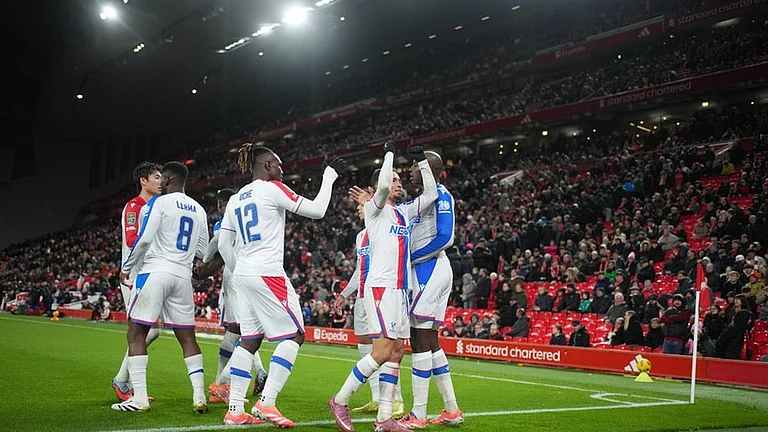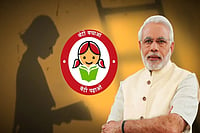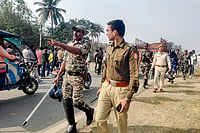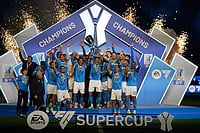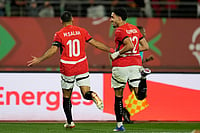
Bademiya
Colaba, Mumbai
In the city that never sleeps, we also need eateries that stay up. For decades, those who party hard in Colaba and dance till the security guards politely lead them out of the premises, didn’t have to worry about late night hunger pangs, thanks to Bademiya. The hip crowd shed their frills and queue up, sweaty and everyone breathing down another’s neck, for dinner and dessert. For decades, those who don’t party at all have also been flocking to Bademiya for their spicy, succulent mutton bhuna rolls and a zillion tava delicacies. Started in the 1940s, Bademiya was a modest stall with an open kitchen. Over the years it has expanded to a bigger eating area and a proper dining restaurant at Horniman Circle.
Videography: Amit Haralkar; Editing: Suraj Wadhwa
The number of cars lining up outside the original eatery, causing a mini traffic jam every night, is enough evidence of its popularity. Drive-in—eat-in-your-car, if we can call it that—has always been popular in Mumbai, even before McDonald’s-type takeaways became popular. Places like Ayub’s, Haji Ali Juice Centre and Bachelors have been catering to the crowd on the move. And Bademiya is the big daddy of them all.

Leopold Café
Colaba, Mumbai
Leopold was buzzing with the mid-week crowd on November 26, 2008, a busy Wednesday, when its packed main hall suddenly resounded with AK-47 fire. It was around 9.30 pm. In just 90 seconds, its walls were splattered with bullets and its floors turned slippery with blood from the wounded guests running out to escape. But Leopold opened four days later, as a message to the terrorists that they can’t win. The whole city cheered and there was a big crowd at its gates, though some did mutter that the owners had shown indecent haste.
Those bullet holes on its walls have been left intact to commemorate the 10 people who were killed that fateful evening, but Leopold is back to its old, gregarious self. The minute you step in, the good cheer, the waiters buzzing about busily with fried prawns or vegetable stroganoff, and the happening bar grip you.
An after-office beer with colleagues, a post-movie drinks and dinner with friends or even sitting alone on a barstool ,nursing a cocktail observing the crowd, with Hotel California or We Didn’t Start the Fire on the pipe, it’s always an evening to cherish at Leopold.

Mahesh Lunch Home
Juhu, Mumbai
You’re on the coast, remember? So you stick to the hallowed routine, as advised by those who have passed here before you, and order crab. A few minutes of chit-chat later, one of the staff comes in with two huge, live specimens—you have to choose. There’s a statistically small but realistic chance that you feel a sense of zodiacal solidarity right then. But no chance. The little girl has already gurgled with delight. And pointed to the bigger one. That settles it, there’s nothing more to do but to submit to about the most heart-warming coastal tide possible in Bombay coming your way. The accent is distinctly Mangalorean. With marginal variations of coconut and kokum and the rest, you could be anywhere between Malvani and Thai. Whether you are at the old haunt in Fort, or at the spiffy new one in Juhu, is only a matter of visual taste.

Soam
Chowpatty, Mumbai
Soam is unlike any other Gujarati restaurant where the motto is not to stuff you with food, but make you savour it. Again, in a rarity for a Gujarati eatery, there is an a la carte menu, not just sumptuous thalis. So, there is a khaman dhokla salad with pomegranate, unmistakably Gujarati but with a delectable twist, or a pav bhaji where the bhaji is made of sprouted moong dal. Soam also keeps doing specially themed food festivals, where, for example, you can have the light-as-soufflé khichdis. At the end of a meal, like in many other Gujarati restaurants, you won’t need the staff’s help to get up.

Mum’s Kitchen
Panjim, Goa
It’s not easy to pick a seafood restaurant in Goa—there are very few that can be called mediocre. But Mum’s Kitchen has a certain warmth, an un-restaurant-like character, almost as if you have come to a friend’s house who loves cooking for lunch. There are the typical Goan preparations—prawns or fish deep fried with rawa or rice flour, gravies brown (roasted coconut and red chillies) or green (green chillies and coriander), xec xec, balchao, recheado, hooman and more. They do a delectable lobster peri peri and a mouth-watering crab meat with butter and garlic. The bar is well stocked and reasonably priced, though most of them are just honest drinks (don’t expect many fancy cocktails). The bebinca (a dessert) may feel too heavy after a light meal of seafood and rice, but it’s one of the best in Panjim, flaky and moist.

Britannia
Ballard Estate, Mumbai
Britannia is one of the few Irani restaurants that still holds on to its old world charm, and more importantly, to its address. Sadly, many others dotting Bombay’s streets have turned into McDonald’s or Burger Kings since the Rs 460 a month rent became a thing of the past. Britannia still serves up its specialties—the berry pulav (served in mutton, chicken, prawn, keema, egg or vegetarian varieties), dhansak, salli boti and the cutlets in true Irani cafe setting—red-and-white checked tablecloth, white crockery, chandelier, biscuits and cakes at the cashier’s desk, collapsible steel shutters and the works. The menu is limited to just a few items, but each one forces the regulars to come back again and again. And the meal always ends with the super-soft caramel custard.

Chetana
Fort, Mumbai
The suburbs of Mumbai may be more happening these days with their uber gastropubs, socials and micro-breweries, but when it comes to the good old hearty Gujarati thali, Chetana in south Bombay has little competition. Tucked in a leafy lane next to Jehangir Art Gallery, Kala Ghoda, Chetana has been serving ‘unlimited’ (though pricey) Gujarati and Rajasthani thali forever—nowadays with add-on Maharashtrian fare. The meal is not for the faint-hearted. Served in heavy, decorated thalis, the helpings include jaljeera, chhas, farsan, seasonal and regular delicacies such as undhiyo with rotlas, puris, phulkas, rice, khichdi and desserts like aam ras. Priced at around Rs 500, what we now shell out for two sandwiches in some places, it is not a bad deal. As a reminder of a bygone era, Chetana stands lonely ever since Samovar and the iconic music store Rhythm House at Kala Ghoda downed their shutters.

Jai Hind Lunch Home
Parel, Mumbai
Like everything in Mumbai, Jai Hind Lunch Home outlets are cramped, functional and awesome. They serve Malvani, Manglorean and a couple of Parsi seafood delicacies such as Patrani Machhi—to be washed down with the deliciously pungent ‘pink drink’ solkadi. You also get buttermilk, but many coastal Maharashtrians believe in not mixing curds or sweets with seafood. Jai Hind Lunch Home, like the chawl across the road that stands its ground among the high rises, still serves what it knows best—squid koli masala, stuffed crabs, kombiwade, jitada, pomfret and prawns, besides innovations like Bombil sandwich (Bombay Duck stuffed with prawns and their special masala). First set up at Parel’s Senapati Bapat Road, for Konkani migrants, it now has several branches serving corporate executives in Lower Parel, and also at the upmarket locations of Pali Naka and Hill Road in Bandra.

Prakash Shakahari Upahar Kendra
Dadar, Mumbai
So how many jibes and jostles can you endure to have the best batata puri—a deep fried delicacy made with sago and potato—or a glassful of piyush, a drink denser than the Punjabi lassi with flavours of srikhand? Prakash Shakahari Upahar Kendra near Sena Bhavan, Shivaji Park, in the heart of Mumbai, is all about traditional Marathi. The current location on Ranade Road is bang opposite where it was established decades ago. With characteristic Marathi simplicity, efficiency and sarcasm, the waiters, dressed in light pink shirts and Gandhi caps, wait on you, mounting quite some pressure if you are the confused sort. So most people end up ordering multiple dishes—misal, khichdi, thalipeeth, vada—and coolers such as raw mango or kokum juice and, of course, piyush whenever a waiter is in sight. The food is worth it, if you aren’t impatient with all the scrambling for a seat. Tea is Rs 22, coffee Rs 38, and masala milk Rs 32—talk about tedious pricing—and they do not accept cards.

Mani’s Lunch Home
Matunga East, Mumbai
much has been made of Onam Sadya at the newly opened Mani’s Lunch Home at Chembur, but the original Mani’s Lunch Home at Matunga East still serves lipsmacking south Indian snacks with kadak kaapi. For students of Ruia College and Podar College of Commerce, it was Mani’s unlimited sambar and chutney that used to be a bonus after hours spent at Five Gardens or Ruia Naka, besides the authentic south Indian coffee, a rarity in a city that runs on cutting-chai. Almost every major nook or corner in Mumbai has its Udipi offering quick meals such as rice plate, masala dosa and uttapam, but none can compare with the many south Indian places near Matunga and King Circle, such as Cafe Madras, Mysore Cafe, Sharada Bhavan, Idli House, Rama Nayak and ‘pure vegetarian’ Mani’s, established in 1937. Among many things adorable about Mani’s is a signboard above the cashier’s counter that says, “All communities welcome”.

Rio Rico
Panaji, Goa
In 1952, Hotel Mandovi, with its restaurant Rio Rico, was the place to go to for an evening out. You weren’t allowed to enter the restaurant without a suit and could dine only if you were a member (monthly fees: Rs 600). The steaks were from South Africa and Argentina, oranges from Israel, potatoes from Holland and apples from Japan. Today, you may not have the ingredients on your plate flown in from abroad, but you also don’t need that suit anymore: Rio Rico has traded the formal attire for a more casual, rather ‘goan’ vibe, with food as good as our grandfathers ate. The old favourites—chicken cafreal, prawn curry and rice with kishmur, and pork vindaloo—are still a hit, many with recipes dating back to the 1950s. And adding a touch of glimmer to their historical Goan and Portuguese cuisine is the royal ambience—a baby grand piano in the centre and the old, Italian marble floor.

Ling’s Pavilion
Colaba, Mumbai
Ling’s Pavilion is clearly not for those who equate Chinese cuisine with veg manchurian and triple schezwan rice. But for those who truly enjoy oriental cuisine, complete with the sauces and soups, Ling’s Pavilion has been a home for the past six decades. One of the oldest Chinese restaurants in the city, Ling’s Pavilion is located in the tourist hotspot of Colaba, which has other popular eateries such as Cafe Mondegar, Leopold and Olympia. Pavilion has always ensured high standards for delicacies such as roast duck, stewed pork, crab meat sauce, fish soups and so on. There are plenty of options for vegetarians too, like the popular braised asparagus or stir fried aubergines. The decor is understated and chic, and the heady mix of alcohol and prawn crackers can turn any lunch plan into a long, lazy, all-afternoon affair, after which one can head to the Gateway of India, just a short walk away.

Agashiye
Ahmedabad, Gujarat
In today’s world of choices, decisions and statements, Agashiye is like going to your parent’s home for a meal if you have been living away. You know everything cooked at home will be your favourites. Agashiye’s (‘fine dining on the terrace’) menu doesn’t list the dishes, but only what they will serve each day of the week. So, on Mondays, the farsan is choli ni kachori, on Fridays it is vatana nu samosa. Saturdays, the main dish will be khichdi and Gujarati kadhi, Tuesdays panchkuti dal and rice. Sundays is an even bigger spread with many extra items.
The polite, unhurried and attentive staff serve you in the correct order; all you have to do is eat the combinations they suggest. You can ask for more of something you really enjoyed, like khata dhokla or srikhand—both are outstanding—but it’s best to just go with the flow of the servers. Most guests have only one complaint—how to get down the three flights of stairs after a meal like this.

Venite
Panjim, Goa
Venite is all atmosphere. It’s hip, happening, ubercool. You will find people rolling cigarettes, someone strumming a guitar and a few others gently gyrating in the cosy, small space. The restaurant is a den of narrow hall, with a few rows of wood-and-cast-iron tables and chairs, walls choc-a-bloc with graffiti and an exquisite balcony. The food is mostly Goan with an eclectic mix of pastas and salads. The pork vindaloo is fiery and tangy, the juices soaked up in pao. Other Goan favourites such as spicy sausages, chicken xacuti and fish fry are all here. The bar is quite busy, but the top-selling drinks are beer and feni, not the fancy cocktails. More than food and drink, though, Venite is an experience—strangers become friends here and Goa feels like home.







